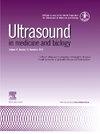Feasibility of Contrast-Enhanced Ultrasound Fusion With Pretreatment MR/CT for Recurrence Detection in Renal Cell Carcinoma Patients During Post-Ablation Surveillance
IF 2.6
3区 医学
Q2 ACOUSTICS
引用次数: 0
Abstract
Objective
Contrast enhanced ultrasound (CEUS) is a cost-effective, safe, and accurate modality for monitoring renal cell carcinoma (RCC) recurrence following percutaneous ablation. However, ultrasound delineation of treated tumor borders can be challenging post-ablation. Here, we demonstrate the feasibility of using post-treatment CEUS fused to preablation MR/CT to detect RCC recurrence during long term follow up.
Methods
This study was performed as part of a larger ongoing prospective clinical trial for patients with biopsy-proven RCC treated with percutaneous ablation and receiving contrast enhanced (CE) -CT or -MRI for treatment response monitoring. CEUS with preablation CT/MR fusion was performed within 4 weeks of recurrence screening, and CE-CT/MRI was used as the reference standard. After intravenous injection of an ultrasound contrast agent, CEUS imaging of a single target lesion was performed with ultrasound fused to the patient's pretreatment CT or MRI. RCC recurrence was diagnosed at the bedside based on the presence of iso- to hyper-enhancement within the margins of the ablation cavity compared to normal renal parenchyma.
Results
To date, 50 participants have been recruited (76% male and 24% female). All participants tolerated the contrast injections without adverse events. CEUS was successfully fused to the participant’s pretreatment cross-sectional imaging in all cases and was found to aid in the delineation of the original treatment zone. Additionally, CEUS correlated perfectly (100% agreement) with CE-CT/MRI findings for all the participants.
Conclusion
Preliminary results demonstrate that post-treatment CEUS fused with a pretreatment CT/MRI is feasible and may aid in the correct localization of the treated tumor margins during long-term post-ablation monitoring.
对比增强超声融合预处理MR/CT用于肾癌消融后复发监测的可行性。
目的:造影增强超声(CEUS)是一种经济、安全、准确的监测肾细胞癌(RCC)经皮消融后复发的方法。然而,消融术后超声对肿瘤边界的描绘可能具有挑战性。在这里,我们证明了在长期随访期间使用治疗后超声造影融合消融前MR/CT检测RCC复发的可行性。方法:这项研究是一项正在进行的更大的前瞻性临床试验的一部分,该试验针对活检证实的RCC患者进行经皮消融治疗,并接受造影增强(CE) -CT或-MRI治疗反应监测。复发筛查4周内行超声造影合并消融前CT/MR融合,以CE-CT/MRI作为参考标准。静脉注射超声造影剂后,超声与患者的预处理CT或MRI融合,对单个目标病变进行超声造影。根据消融腔边缘相对于正常肾实质的等或高强化,在床边诊断RCC复发。结果:迄今为止,已招募了50名参与者(76%为男性,24%为女性)。所有参与者均耐受造影剂注射,无不良反应。在所有病例中,超声造影都成功地融合到参与者的预处理横断成像中,并被发现有助于描绘原始治疗区域。此外,CEUS与所有参与者的CE-CT/MRI结果完全相关(100%一致)。结论:初步结果表明,治疗后超声造影与预处理CT/MRI融合是可行的,并有助于在消融后长期监测中正确定位治疗后肿瘤边缘。
本文章由计算机程序翻译,如有差异,请以英文原文为准。
求助全文
约1分钟内获得全文
求助全文
来源期刊
CiteScore
6.20
自引率
6.90%
发文量
325
审稿时长
70 days
期刊介绍:
Ultrasound in Medicine and Biology is the official journal of the World Federation for Ultrasound in Medicine and Biology. The journal publishes original contributions that demonstrate a novel application of an existing ultrasound technology in clinical diagnostic, interventional and therapeutic applications, new and improved clinical techniques, the physics, engineering and technology of ultrasound in medicine and biology, and the interactions between ultrasound and biological systems, including bioeffects. Papers that simply utilize standard diagnostic ultrasound as a measuring tool will be considered out of scope. Extended critical reviews of subjects of contemporary interest in the field are also published, in addition to occasional editorial articles, clinical and technical notes, book reviews, letters to the editor and a calendar of forthcoming meetings. It is the aim of the journal fully to meet the information and publication requirements of the clinicians, scientists, engineers and other professionals who constitute the biomedical ultrasonic community.

 求助内容:
求助内容: 应助结果提醒方式:
应助结果提醒方式:


